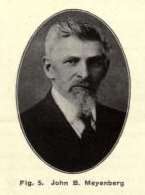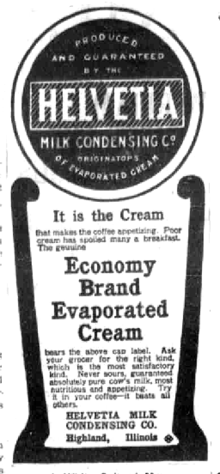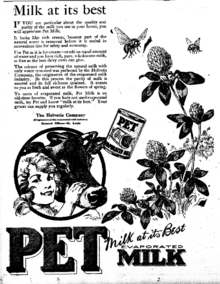Pet, Inc.
Pet, Inc., was an American company that was the first to commercially produce evaporated milk as a shelf-stable consumer product[1] and later became a multi-brand food products conglomerate.[2] Its signature product, PET Evaporated Milk, is now a product of The J.M. Smucker Company. PET Dairy is a regional brand of fresh and processed dairy products in the Southeastern United States made by the Land-O-Sun division of Dean Foods. Many of the remaining brands once owned by Pet, Inc. are currently part of General Mills.
.png)
History
Evaporated milk was a popular product before refrigerators were common in homes, but is now a niche product mainly used in baking and other recipes. PET anticipated the change, and transformed into a food products conglomerate through a series of acquisitions. It was also the subject of acquisitions, primarily due to its Old El Paso line, Progresso line, and other brands, and not because of the evaporated milk. Progresso soup cans currently maintain the copyright notice of Pet, Inc.
John Baptist Meÿenberg


John Baptist Meÿenberg (1847-1914) was an operator at the Anglo-Swiss milk condensery at Cham, Switzerland. Anglo-Swiss made sweetened condensed milk. From 1866 through 1883, Meÿenberg experimented with preservation of milk without the use of sugar. He discovered that condensed milk would last longer if heated to 120 °C (248 °F) in a sealed container, and hence could be preserved without adding sugar. When Anglo-Swiss declined to implement Meÿenberg's work, he resigned from the company and emigrated to the United States. John Meÿenberg first moved to St. Louis, but soon relocated to Highland, Illinois, due to its large Swiss population. On 25 November 1884, U.S. Patents 308,421 (Apparatus for Preserving Milk) and 308,422 (Process for Preserving Milk) were issued to Meÿenberg. Meÿenberg associated with various local merchants, including John Wildi, Louis Latzer, Dr. Knoebel, George Roth and Fred Kaeser and, on February 14, 1885, organized the Helvetia Milk Condensing Company.[3]
The company commenced operations in a closed wool factory. Helvetia started processing 300 gallons of raw milk a day. On 8 July 1885, the steam-powered sterilizer exploded and Helvetia Milk Condensing Company closed operations for repairs. Milk canned in early 1886 spoiled. Although John Meÿenberg believed that cans were inadequately sealed, others claimed that Meÿenberg's sterilization process was the cause. Due to this criticism, Meÿenberg left in August 1886.
In 1899, Meÿenberg assisted Elbridge Amos Stuart in producing Carnation Evaporated Milk.
Successful production

Louis Latzer assumed the role of technical director. He determined that the spoilage was caused by bacteria and resolved the problem. John Wildi was instrumental in marketing the product nationally and internationally, especially in areas where fresh milk or refrigeration were scarce. In 1895, the company registered the Pet trademark. In 1907, John Wildi separated from the company and organized the John Wildi Evaporated Milk Company in Columbus, Ohio. During World War I, American troops referred to a Helvetia milk can as a "Tin Cow". In 1923, the Helvetia Milk Condensing was renamed the Pet Milk Company after its signature product "Our Pet Evaporated Cream". In 1929, Pet established the PET Dairy division by acquiring a fluid milk processing plant in Johnson City, Tennessee.[4]
Foods conglomerate
- In 1950, Pet Evaporated Milk sales peaked.[5]
- Transformed into a food products conglomerate with the purchase of many brands in the early 1960s, including C. H. Musselman, Whitman's, Downyflake, and R. E. Funsten.
- Sego diet drink, introduced..[6]
- In 1962, Pet Milk Company announced the closing of its factory in New Glarus, Wisconsin.
- Changed name to Pet Incorporated in 1966 and merged with the Hussmann Refrigerator Company.
- In 1968, Pet acquired the Mountain Pass Canning Company, maker of the Old El Paso brand of Mexican food products. It also acquired Schrafft's the same year in a deal factored at $25 million.
- Acquired by IC Industries (ICI) in 1978. Hussmann and Pet were made into separate divisions of ICI.
- In 1981, ICI sold the Musselman division, now part of Knouse Foods
- In 1982, the William Underwood Company was acquired, bringing with it the brands B&M and Ac'cent.
- In 1985, the PET Dairy division was sold to the Challer Foods subsidiary of Finevest Dairy Holdings.[7] This did not include the canned milk products.
- In 1986, Pet acquired Ogden Food Products (including the brands Progresso, Las Palmas, Hollywood, and Hain) and Primo Foods, an Italian foods marketer.
- in 1988, ICI changed its name to Whitman Corp.
- Acquired Orval Kent, a prepared salad maker, in 1989.[8]
- In 1990, Pet, Inc. was spun off of Whitman.[9]
- In 1993, Pet sold the Whitman's chocolate brand to Russell Stover Candies.
- In 1994, Orval Kent was sold to Horizon Partners, a private equity group in Milwaukee.[10]
- In 1995, Pet was acquired by the Pillsbury Company division of Grand Metropolitan. Major brands of interest are Old El Paso and Progresso.[11]
- In 1997, Grand Met merged with Guinness to form Diageo.
- In 1999, Pillsbury sold the William Underwood business to B&G Foods.
- In 2000, General Mills acquired Pillsbury (incl. Pet) from Diageo.[12]
- In 2001, to satisfy the US FTC, Diageo and General Mills agreed to sell several, but not all, Pillsbury brands to International Multifoods.[13][14] This included the PET Evaporated Milk and PET dry creamer products.[15]
- In 2004, The J.M. Smucker Company acquired Multifoods.[16]
Bibliography
- A Portrait of Progress: A Business History of Pet Milk Company from 1885 to 1960, by Martin L. Bell, PhD, 1962.
References
- Hunziker, O. F. (1918) [1914]. Condensed milk and milk powder: prepared for the use of milk condenseries, dairy students and pure food departments (2 ed.). LaGrange, IL: author. p. 22. Retrieved 2008-08-29.
While, for several years before the organization of this company, the possibilities of producing a sterile unsweetened condensed milk were essayed in laboratory investigations by scientists, and while simultaneously with the commencement of operations of this company, several other companies also experimented on this form of condensed milk, the Helvetia Milk Condensing Company was the first organization that succeeded in producing a marketable unsweetened condensed milk that was sterile and would keep indefinitely.
- Company profile as of the late 1990s
- The Canning Clan, by Earl Chapin May. New York: the Macmillan Company, 1937
- PET Dairy history
- Answer.com profile of PET
- "Pet Incorporated". Harvard University, Baker Library, Lehman Brothers Collection.
- PET Dairy sold
- Pet Inc. takeover of Orval Kent Food Co
- Whitman Revamping; Will Spin Off Pet Inc.
- Orval Kent briefly owned by Pet
- Grand Met Makes $2.6 Billion Offer for Pet Inc.
- Pillsbury History
- FTC Statement regarding approval of transaction Archived 2009-01-18 at the Wayback Machine
- General Mills completes sale of businesses to Multifoods
- SEC report 8-K regarding acquisition of PET and other brands. Limited to PET Evaporated Milk and dry creamer
- Smucker's announcement of Multifoods acquisition Archived 2009-02-17 at the Wayback Machine
External links
- J. M. Smuckers' PET Milk website
- Dean Foods' PET Dairy website
- U.S. Patent 308,421, Apparatus for Preserving Milk
- U.S. Patent 308,422, Process for Preserving Milk
- U.S. Patent No. 358,213, Process of Evaporating Milk
- 1966 Advertisement for SEGO Diet Food by PET
